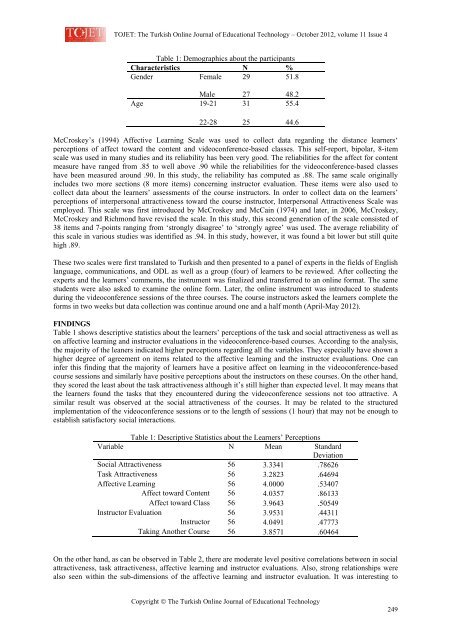october 2012 - TOJET the Turkish online journal of educational ...
october 2012 - TOJET the Turkish online journal of educational ...
october 2012 - TOJET the Turkish online journal of educational ...
Create successful ePaper yourself
Turn your PDF publications into a flip-book with our unique Google optimized e-Paper software.
<strong>TOJET</strong>: The <strong>Turkish</strong> Online Journal <strong>of</strong> Educational Technology – October <strong>2012</strong>, volume 11 Issue 4<br />
Table 1: Demographics about <strong>the</strong> participants<br />
Characteristics N %<br />
Gender Female 29 51.8<br />
Male 27 48.2<br />
Age 19-21 31 55.4<br />
22-28 25 44.6<br />
McCroskey’s (1994) Affective Learning Scale was used to collect data regarding <strong>the</strong> distance learners‘<br />
perceptions <strong>of</strong> affect toward <strong>the</strong> content and videoconference-based classes. This self-report, bipolar, 8-item<br />
scale was used in many studies and its reliability has been very good. The reliabilities for <strong>the</strong> affect for content<br />
measure have ranged from .85 to well above .90 while <strong>the</strong> reliabilities for <strong>the</strong> videoconference-based classes<br />
have been measured around .90. In this study, <strong>the</strong> reliability has computed as .88. The same scale originally<br />
includes two more sections (8 more items) concerning instructor evaluation. These items were also used to<br />
collect data about <strong>the</strong> learners’ assessments <strong>of</strong> <strong>the</strong> course instructors. In order to collect data on <strong>the</strong> learners’<br />
perceptions <strong>of</strong> interpersonal attractiveness toward <strong>the</strong> course instructor, Interpersonal Attractiveness Scale was<br />
employed. This scale was first introduced by McCroskey and McCain (1974) and later, in 2006, McCroskey,<br />
McCroskey and Richmond have revised <strong>the</strong> scale. In this study, this second generation <strong>of</strong> <strong>the</strong> scale consisted <strong>of</strong><br />
38 items and 7-points ranging from ‘strongly disagree’ to ‘strongly agree’ was used. The average reliability <strong>of</strong><br />
this scale in various studies was identified as .94. In this study, however, it was found a bit lower but still quite<br />
high .89.<br />
These two scales were first translated to <strong>Turkish</strong> and <strong>the</strong>n presented to a panel <strong>of</strong> experts in <strong>the</strong> fields <strong>of</strong> English<br />
language, communications, and ODL as well as a group (four) <strong>of</strong> learners to be reviewed. After collecting <strong>the</strong><br />
experts and <strong>the</strong> learners’ comments, <strong>the</strong> instrument was finalized and transferred to an <strong>online</strong> format. The same<br />
students were also asked to examine <strong>the</strong> <strong>online</strong> form. Later, <strong>the</strong> <strong>online</strong> instrument was introduced to students<br />
during <strong>the</strong> videoconference sessions <strong>of</strong> <strong>the</strong> three courses. The course instructors asked <strong>the</strong> learners complete <strong>the</strong><br />
forms in two weeks but data collection was continue around one and a half month (April-May <strong>2012</strong>).<br />
FINDINGS<br />
Table 1 shows descriptive statistics about <strong>the</strong> learners’ perceptions <strong>of</strong> <strong>the</strong> task and social attractiveness as well as<br />
on affective learning and instructor evaluations in <strong>the</strong> videoconference-based courses. According to <strong>the</strong> analysis,<br />
<strong>the</strong> majority <strong>of</strong> <strong>the</strong> leaners indicated higher perceptions regarding all <strong>the</strong> variables. They especially have shown a<br />
higher degree <strong>of</strong> agreement on items related to <strong>the</strong> affective learning and <strong>the</strong> instructor evaluations. One can<br />
infer this finding that <strong>the</strong> majority <strong>of</strong> learners have a positive affect on learning in <strong>the</strong> videoconference-based<br />
course sessions and similarly have positive perceptions about <strong>the</strong> instructors on <strong>the</strong>se courses. On <strong>the</strong> o<strong>the</strong>r hand,<br />
<strong>the</strong>y scored <strong>the</strong> least about <strong>the</strong> task attractiveness although it’s still higher than expected level. It may means that<br />
<strong>the</strong> learners found <strong>the</strong> tasks that <strong>the</strong>y encountered during <strong>the</strong> videoconference sessions not too attractive. A<br />
similar result was observed at <strong>the</strong> social attractiveness <strong>of</strong> <strong>the</strong> courses. It may be related to <strong>the</strong> structured<br />
implementation <strong>of</strong> <strong>the</strong> videoconference sessions or to <strong>the</strong> length <strong>of</strong> sessions (1 hour) that may not be enough to<br />
establish satisfactory social interactions.<br />
Table 1: Descriptive Statistics about <strong>the</strong> Learners’ Perceptions<br />
Variable N Mean Standard<br />
Deviation<br />
Social Attractiveness 56 3.3341 .78626<br />
Task Attractiveness 56 3.2823 .64694<br />
Affective Learning 56 4.0000 .53407<br />
Affect toward Content 56 4.0357 .86133<br />
Affect toward Class 56 3.9643 .50549<br />
Instructor Evaluation 56 3.9531 .44311<br />
Instructor 56 4.0491 .47773<br />
Taking Ano<strong>the</strong>r Course 56 3.8571 .60464<br />
On <strong>the</strong> o<strong>the</strong>r hand, as can be observed in Table 2, <strong>the</strong>re are moderate level positive correlations between in social<br />
attractiveness, task attractiveness, affective learning and instructor evaluations. Also, strong relationships were<br />
also seen within <strong>the</strong> sub-dimensions <strong>of</strong> <strong>the</strong> affective learning and instructor evaluation. It was interesting to<br />
Copyright © The <strong>Turkish</strong> Online Journal <strong>of</strong> Educational Technology<br />
249
















